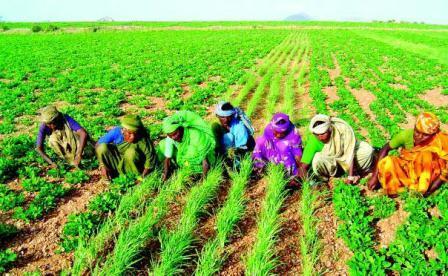Strip crop - A ray of hope for dry land farmers
Strip crop - A ray of hope for dry land farmers

Chinnahagari and Upparahalla watersheds of Chitradurga and Bellary districts belong to the dry belts of Karnataka. Moreover, these regions are prone to frequent droughts. Shallow soils, low organic matter in the soils and the prevalent poor moisture conservation practices could support production of only the resilient crop like groundnut and nothing else. Groundnut is the only crop grown through out the year. About 80% of the farmers depend on groundnut crop as their major livelihood option. There are hardly any other options excepting wage labour and migration. Monocropping of groundnut has been the trend prevalent since thirty years. About 300 mm total rainfall, occurring at critical stages of the crop, would ensure decent yields of pods and fodder. The gross income of groundnut cultivation, during a year of normal rainfall was as low as Rs. 2000-3000 per acre.
Karnataka Watershed Development (KAWAD) project was initiated in the area between 2002 and 2005, to improve the food and income security of the farmers in the region. Extensive work was undertaken in the project on bunding, gully plugging, treating the water courses etc. AME Foundation (AMEF), as a project partner facilitated the process of improving farming systems.
Apart from promoting in-situ soil and moisture conservation practices and soil fertility improvements, AMEF was also aiming at addressing the groundnut monocropping practice through exploring other options for the farmers. But, groundnut being a cash fetching crop, farmers were not willing to forego a season with cereals replacing groundnut. It was in this context that an alternative to introducing cereals into the cropping pattern had to be thought of. Minor millets known as drought tolerant and poor man’s crops require moisture for germination and thrive thereafter to give some guaranteed yields. So strips of cereal crop were introduced amidst strips of groundnut crop by the farmers. This technology is popularly called as strip cropping.
Farmers trying out strip cropping
The strip cropping technology was new to farmers. Farmers had their apprehensions about the technology, as well. They perceived risk of shade effect of cereal crops on groundnut. They feared that the economic returns from finger millet or bajra (options for strip crop) would be less compared to groundnut. Although finger millet and bajra were considered as possible options, almost all farmers adopted groundnut and finger millet combination.
Operational constraints
There were operational constraints in adopting the technology, as well. A three-coultered bullock-drawn seed drill is normally used for groundnut sowing. The farmers agreed to go for 9:6 groundnut, finger millet rows. The difference in the size of seeds of groundnut and finger millet required the labourers to adjust the sowing depth while alternating between groundnut and finger millet. Despite care in sowing, some farmers could not help poor germination of finger millet due to deep sowing. And, the grasshopper infestation on finger millet also led to poor crop stand, which forced some farmers resorting to resowing with groundnut. When sowing is done in north-south direction, stunted growth of groundnut crop was noticed adjacent to the finger millet rows due to shade effect. Ultimately, 27 farmers, managed to continue with the strip crop.
More than money
Groundnuts under strip crop method produced 276 kgs on an average while the plots with groundnut alone produced 362 kgs per acre (Table 1). Though this seems to be lesser in absolute terms, however, the total production in a strip crop method is much higher as it also includes production of millets to the extent of 125 kg of grain from the same piece of land. Farmers could therefore get cash returns worth Rs.5507 from sale of groundnut pods and fodder and finger millet fodder along with grain for family consumption.
Among the two watersheds, strip crop of groundnut performed better in Upparahalla despite the region receiving less than the normal rainfall. Strip cropping thus proved to be a drought mitigation strategy.
Alternating groundnut with finger millet also helped in reducing the pest attack. Finger millet, acted as a barrier to the movement of sucking pests like thrips, which transmit a viral disease, peanut bud necrosis (PBND). Incidence of soil borne diseases were also found less as the pathogens starve due to change of host when other crops are mixed with groundnut.
Including finger millet has appealed to women the most, for the simple reason that, the practice contributes to family food security. Women are now particularly keen on growing leafy vegetables and other short duration pulses like horse gram and cowpea in strips for home consumption and for selling in the local market. However, the new practice has not influenced their workload.
Farmers also found one more advantage of having strip crops. In the conventional practice, farmers used to uproot the entire groundnut crop, thus leaving nothing in the soil. But the inclusion of cereal crops, enables them to leave the residues of finger millet crop after grain harvest, thus returning back some plant nutrients into the soil.
Groundnut farmers normally purchased straw of paddy or other cereals to store groundnut harvest. Now, the stalks of finger millet is used to cover the heaps of groundnut in store yard, thus reducing their expenditure.
Authors: Gurudatt Hegde, Ravindranath Reddy, Arun Balamatti, AME Foundation, No. 204, 100 Feet Ring Road, 3rd Phase, Banashankari 2nd Block, 3rd Stage, Bangalore – 560085
Source : LEISA India, Vol 7-2
Last Modified : 2/12/2020
